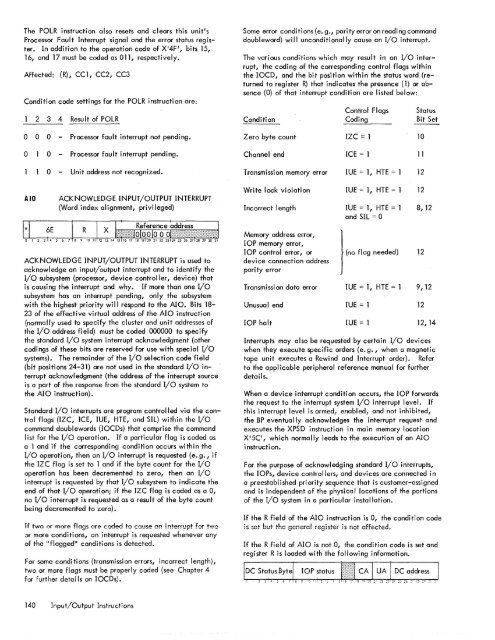1. xerox 560 computer system - The UK Mirror Service
1. xerox 560 computer system - The UK Mirror Service
1. xerox 560 computer system - The UK Mirror Service
You also want an ePaper? Increase the reach of your titles
YUMPU automatically turns print PDFs into web optimized ePapers that Google loves.
<strong>The</strong> POLR instruction also resets and clears this unit'sProcessor Fault Interrupt signal and the error status register.In addition to the operation code of X'4F', bits 15,16, and 17 must be coded as 011 , respectively.Affected: (R), CC1, CC2, CC3Condition code settings for the POLR instruction are:2 3 4 Result of POLRSome error conditi ons (e. g., parity error on reading commanddoubleword) will unconditionally cause an I/O interrupt.<strong>The</strong> various conditions which may result in an I/O interrupt,the coding of the corresponding control flags withinthe lOCO, and the bit position within the status word (returnedto register R) that indicates the presence (1) or absence(0) of that interrupt condition are listed below:ConditionControl FlagsCodingStatusBit Seto 0 0 - Processor fault interrupt not pending.Zero byte countIZC = 110o o -Processor fault interrupt pending.Channel endICE = 111o -Unit address not recognized.T~ansmission memory errorIUE = 1, HTE = 112AIDACKNOWLEDGE INPUT/OUTPUT INTERRUPT(Word index alignment, privileged)Write lock violationIncorrect lengthIUE = 1, HTE = 1IUE = 1, HTE = 1and SIL = 0128, 12ACKNOWLEDGE INPUT/OUTPUT INTERRUPT is used toacknowledge an input/output interrupt and to identify theI/O sub<strong>system</strong> (processor, device controller, device) thatis causing the interrupt and why. If more than one I/osub<strong>system</strong> has an interrupt pending, only the sub<strong>system</strong>with the highest priority will respond to the AIO. Bits 18-23 of the effective virtual address of the AIO instruction(normally used to specify the cluster and unit addresses ofthe I/O address field) must be coded 000000 to specifythe standard I/O <strong>system</strong> interrupt acknowledgment (othercodings of these bits are reserved for use with special I/O<strong>system</strong>s). <strong>The</strong> remainder of the I/o selection code field(bit positions 24-31) are not used in the standard I/O interruptacknowledgment (the address of the interrupt sourceis a part of the response from the standard I/O <strong>system</strong> tothe AIO instruction).Standard I/O interrupts are program controlled via the controlflags (IZC, ICE, IUE, HTE, and SIL) within the I/ocommand doublewords (lOCOs) that comprise the commandlist for the I/o operation. If a particular flag is coded asa 1 and if the corresponding condition occurs within theI/O operation, then an I/O interrupt is requested (e. g. , ifthe IZC flag is set to 1 and if the byte count for the I/Ooperation has been decremented to zero, then an I/Ointerrupt is requested by that I/o sub<strong>system</strong> to indicate theend of that I/O operation; if the IZC flag is coded as a 0,no I/O interrupt is requested as a result of the byte countbei ng decremented to zero).If two or more flags are coded to ClJuse lJn !nterrupt for twoor more conditions, an interrupt is requested whenever anyof the IIflagged ll conditions is detected.For some conditions (transmission errors, incorrect length),two or more flags must be properly coded (see Chapter 4for further details on lOCOs).Memory address error IlOP memory error,lOP control error, ordevice connection addressparity errorT ransm i ssi on data errorUnusual endlOP halt) (no flag needed)IUE=l,HTE=lIUE = 1IUE = 1129, 121212, 14Interrupts may also be requested by certain I/O deviceswhen they execute specific orders (e. g., when a magnetictape unit executes a Rewind and Interrupt order). Referto the applicable peripheral reference manual for furtherdetails.When a device interrupt condition occurs, the lOP forwardsthe request to the interrupt <strong>system</strong> I/o interrupt level. Ifthis interrupt level is armed: enabled: and not inhibited;the BP eventually acknowledges the interrupt request andexecutes the XPSD instruction in main memory locationX ' 5C', which normally leads to the execution of an AIOi nstructi on.For the purpose of acknowledging standard I/O interrupts,the lOPs, device controllers, and devices are connected ina preestablished priority sequence that is customer-assignedand is independent of the physical locations of the portionsof the I/o <strong>system</strong> in a particular installation.If the R field of the AIO instruction is 0, the condition code;s set but the genera! iegistsi is not affected.If the R field of AIO is not 0, the condition code is set andregister R is loaded with the following information.140 Input/Output Instructions
















